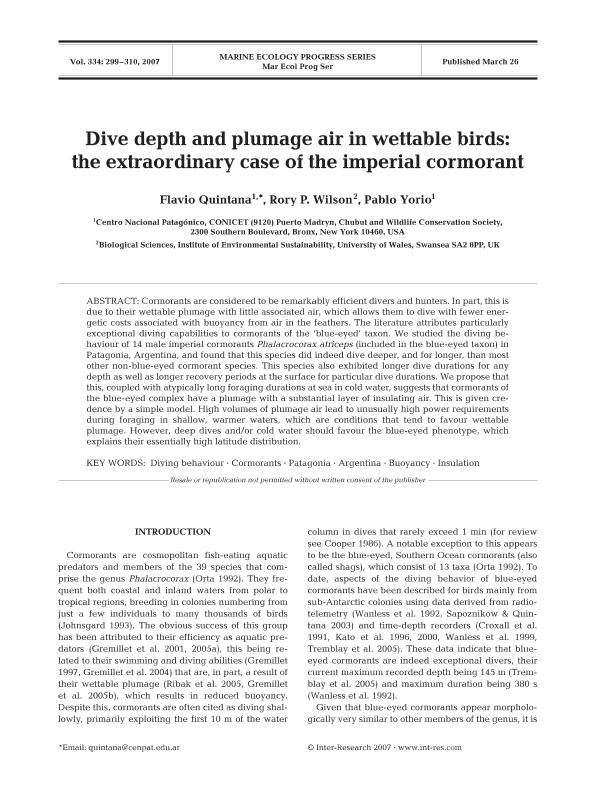Mostrar el registro sencillo del ítem
dc.contributor.author
Quintana, Flavio Roberto

dc.contributor.author
Wilson, Rory P.

dc.contributor.author
Yorio, Pablo Martin

dc.date.available
2020-04-23T18:13:56Z
dc.date.issued
2007-12
dc.identifier.citation
Quintana, Flavio Roberto; Wilson, Rory P.; Yorio, Pablo Martin; Dive depth and plumage air in wettable birds: the extraordinary case of the imperial cormorant; Inter-Research; Marine Ecology Progress Series; 334; 12-2007; 299-310
dc.identifier.issn
0171-8630
dc.identifier.uri
http://hdl.handle.net/11336/103481
dc.description.abstract
Cormorants are considered to be remarkably efficient divers and hunters. In part, this is due to their wettable plumage with little associated air, which allows them to dive with fewer energetic costs associated with buoyancy from air in the feathers. The literature attributes particularly exceptional diving capabilities to cormorants of the ‘blue-eyed’ taxon. We studied the diving behaviour of 14 male imperial cormorants Phalacrocorax atriceps (included in the blue-eyed taxon) in Patagonia, Argentina, and found that this species did indeed dive deeper, and for longer, than most other non-blue-eyed cormorant species. This species also exhibited longer dive durations for any depth as well as longer recovery periods at the surface for particular dive durations. We propose that this, coupled with atypically long foraging durations at sea in cold water, suggests that cormorants of
the blue-eyed complex have a plumage with a substantial layer of insulating air. This is given credence by a simple model. High volumes of plumage air lead to unusually high power requirements during foraging in shallow, warmer waters, which are conditions that tend to favour wettable plumage. However, deep dives and/or cold water should favour the blue-eyed phenotype, which
explains their essentially high latitude distribution.
dc.format
application/pdf
dc.language.iso
eng
dc.publisher
Inter-Research

dc.rights
info:eu-repo/semantics/openAccess
dc.rights.uri
https://creativecommons.org/licenses/by-nc-sa/2.5/ar/
dc.subject
DIVING BEHAVIOR
dc.subject
CORMORANTS
dc.subject
PATAGONIA
dc.subject
ARGENTINA
dc.subject
BUOYANCY
dc.subject
INSULATION
dc.subject.classification
Ecología

dc.subject.classification
Ciencias Biológicas

dc.subject.classification
CIENCIAS NATURALES Y EXACTAS

dc.title
Dive depth and plumage air in wettable birds: the extraordinary case of the imperial cormorant
dc.type
info:eu-repo/semantics/article
dc.type
info:ar-repo/semantics/artículo
dc.type
info:eu-repo/semantics/publishedVersion
dc.date.updated
2020-04-02T14:14:59Z
dc.identifier.eissn
1616-1599
dc.journal.volume
334
dc.journal.pagination
299-310
dc.journal.pais
Alemania

dc.journal.ciudad
Olderndorf
dc.conicet.avisoEditorial
Early volumes (more than five years since publication) are freely accessible to all users. They are listed according to the subscription year to which they belonged. All abstracts and full article pdfs in this issue are available to all users, compliments of Inter-Research.
dc.description.fil
Fil: Quintana, Flavio Roberto. Wildlife Conservation Society; Estados Unidos. Consejo Nacional de Investigaciones Científicas y Técnicas. Centro Científico Tecnológico Conicet - Centro Nacional Patagónico. Instituto de Biología de Organismos Marinos; Argentina
dc.description.fil
Fil: Wilson, Rory P.. University of Wales; Reino Unido
dc.description.fil
Fil: Yorio, Pablo Martin. Wildlife Conservation Society; Estados Unidos. Consejo Nacional de Investigaciones Científicas y Técnicas. Centro Científico Tecnológico Conicet - Centro Nacional Patagónico; Argentina
dc.journal.title
Marine Ecology Progress Series

dc.relation.alternativeid
info:eu-repo/semantics/altIdentifier/url/https://www.int-res.com/articles/meps2007/334/m334p299.pdf
Archivos asociados
